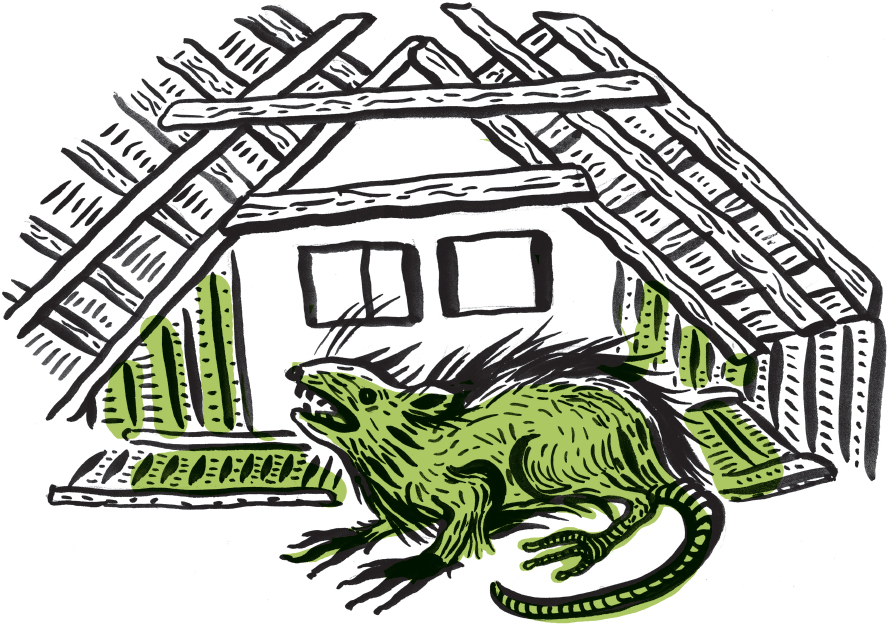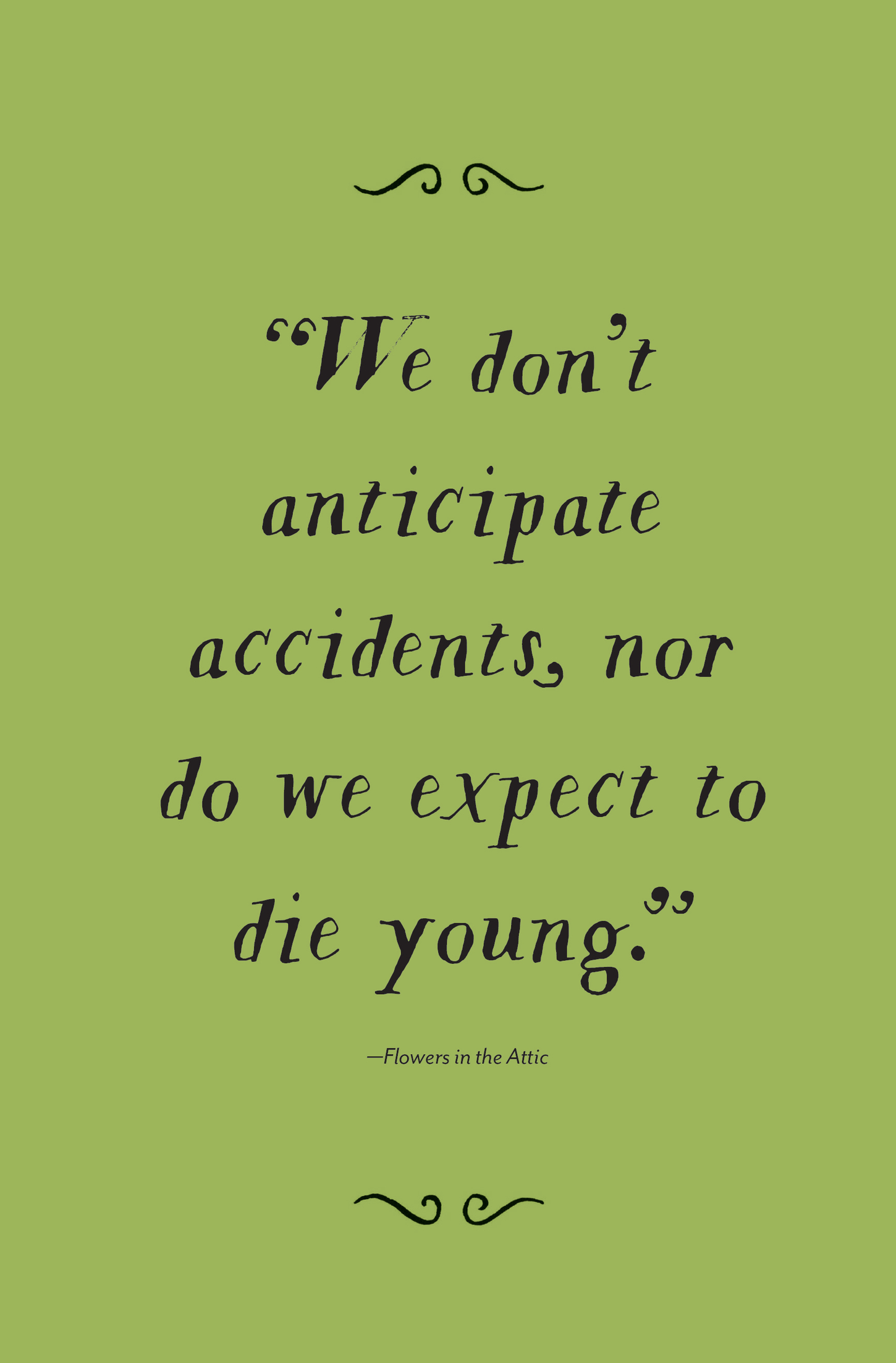 Nightmares in the Attic
Nightmares in the Attic 
V. C. Andrews
Ann Radcliffe wrote Gothic novels that caused a craze in the 1790s, and no author since then has whipped readers into such a frenzy with deliciously dramatic horror set in gloomy forests and crumbling mansions. Not until V. C. Andrews took the literary stage, that is. Andrews combined the elements of Gothic horror with soap-opera-style family drama. And she included more than enough incestuous plot lines to keep her audience mesmerized.
Born and raised in Portsmouth, Virginia, Cleo Virginia Andrews had a difficult childhood. From a young age she suffered from crippling rheumatoid arthritis that was unresponsive to surgical treatments; at times she was wheelchair bound or dependent upon crutches. Still, she excelled at her studies and earned an art degree via a correspondence program that allowed her to work from home. She started her career as a commercial artist, but her writing became her lifeline to the outside world. Andrews never married or had children. Due to her health problems, which left her in pain and largely immobile, she lived with her mother for most of her life.
Andrews started writing in the early 1970s, producing what she called “confession stories” in order to “finance [her] more serious efforts,” as she wrote in a pitch letter to the literary agent Anita Diamant. Those serious efforts included the first novel she wrote, though not her first to be published, a science-fiction work called Gods of Green Mountain (published posthumously in 2004 by Pocket Books). The book is set on a distant planet that has been ravaged by two suns and endless storms, and it’s packed with typical space-opera fare such as a princess, a reckless hero, outlaws, and civil war, plus a mysterious plant that can solve the world’s problems. But Andrews’s so-called confession stories that paid the bills early in her career are more interesting. The titles alone are packed with tawdry details.
Take, for example, “I Slept with My Uncle on My Wedding Night,” which has become practically apocrypha for Andrews fans. It was published in a pulp magazine, but the publication details have been lost and no copies exist. Certainly the story anticipates Andrews’s most famous book: Flowers in the Attic (Simon and Schuster, 1979), which introduced the Dollanganger family, whose saga would unfold over five novels. That first book was a runaway hit right out of the gate, staying on the New York Times Best-Seller List for fourteen weeks. The sequel spent nineteen weeks on the list.
It’s a Family Affair
The plot of Flowers is Gothic horror in its purest form: four children—beautiful, blonde cherubs all of them—are locked in the attic of Foxworth Hall by their wealthy, abusive, emotionally frigid grandmother. The scenario is a bizarre attempt by their mother to keep her virginal reputation intact so she can secure the family fortune. The book is full of twisted relationships, especially the grandmother’s to religion, which is terrifying and the reason for the abuse that borders on torture. She can yell about sin as well as Carrie’s mother (no mention of “dirty pillows” in this book, though). But the relationship that scandalized readers the most was between the two oldest Dollanganger children, who fall in love while trapped in that lonely attic, their teenage hormones raging.
It could be a sweet story, really, but the horror is real. The mother, who at the beginning of the novel seems to be a loving and protective caregiver, becomes a monster, willing to sacrifice her daughters for wealth. The youngest child dies. There’s also rape. And rats.

The child incest was sufficient to get Andrews’s book banned from several libraries, but the story was popular enough to support immediate sequels, in which readers learn that the Dollanganger family had a long history of incestual romance. Andrews created other franchises that were just as juicy. The Audrina series, beginning with My Sweet Audrina (Simon & Schuster, 1982), involved another child locked away in a Gothic mansion, this one haunted by the ghostly memories of a sister who is long dead (or is she?). Andrews’s books about the Casteel family, beginning with Heaven (HarperCollins, 1985), offer more dead children, a wealthy elite who scorn the impoverished family, and a creepy doll made to look just like a dead woman.
Andrews’s writing career was lucrative. She sold her first book to Simon & Schuster’s Pocket imprint for $7,500, and two sequels were immediately ordered, with a $50,000 advance. Heaven brought in $2 million and was part of a two-book deal. In addition to making her wealthy, Andrews’s novels served as a rite of passage for would-be Goth girls. The lure of secret incest in an old manor house is too great to resist. But Andrews’s work is more than a guilty pleasure. It’s Gothic fiction directly descended from the lineage of Anne Radcliffe. Her work is melodramatic, yes, but it’s also packed with compelling characters, especially women, caught up in villainous schemes.
Unfortunately, Andrews could not keep up with her growing career. Her already fragile health declined, and she was in constant pain. While writing Heaven and its sequel, which were her final books, she discovered a lump in her breast that turned out to be cancer. She didn’t want to seek medical treatment until the books were finished, by which time the illness had spread to other parts of her body.
After Andrews passed away in 1986, her estate kept her literary legacy alive through a ghostwriter. Andrew Neiderman stepped in to pen mass-market paperbacks under her name, using some of her unfinished outlines as inspiration. Her novels continue to sell well decades after her death. Some readers speculate whether her salacious plots have a basis in her life. Maybe her early “confession stories” have something to do with that rumor.
Newcomers to V. C. Andrews’s novels can expect the following elements:
• The drinking of blood. In Flowers in the Attic, food becomes scarce and so the children turn to feeding on the blood of the oldest brother.
• Incest. The most famous example is between the blonde cherublike siblings in Flowers in the Attic. But Andrews’s work also depicts problematic scenes in which consent is neglected.
• Child torture and slavery. Children don’t fare well in Andrews’s novels; they’re often drugged, poisoned, tarred (yes, you read that right), and sometimes sold for moonshine money. Who are these parents?
• A tiger mauling a kid. In the United States of America. We don’t need to say more about this, do we?
Reading List
Not to be missed: If Flowers in the Attic leaves you wanting additional melodramatic horror, read the rest of the Dollanganger series. The subsequent books feature possession by the spirits of dead relatives and, perhaps more disturbingly, one of the children becoming a televangelist.
Also try: My Sweet Audrina features a classic 1970s keyhole cover (in which a portion of the cover is cut out, revealing an elaborate illustration underneath); the original paperback is worth tracking down for that alone, never mind the story’s sweet twist ending. Flowers in the Attic has been adapted for the screen several times; the 1987 version, starring Kristy Swanson (the original Buffy the Vampire Slayer) as the oldest sister Cathy, has a strong fandom, although it gets some of the book’s key details wrong and nearly erases the incest, leaving only a few longing looks. In 2014, Lifetime made a television version starring Ellen Burstyn as the grandmother and Kiernan Shipka (of Netflix’s The Chilling Adventures of Sabrina) as Cathy. Although not perfect, this version is a closer adaptation and plays up the book’s Gothic and horror aspects.
Related work: Andrews fans may also like the work of Lois Duncan, who wrote young adult horror and thrillers. Duncan’s work never deals with sex or incest in quite the same way that Andrews’s does, but Duncan does push boundaries. In Killing Mr. Griffin (Little, Brown, 1978), a group of teenagers accidentally kills one of their high school teachers. Similarly, high school friends find themselves hiding a murder—and running from a murderer—in I Know What You Did Last Summer (Little, Brown, 1973), which was made into a well-known movie in 1997. Duncan’s Gothic horror novel is Down a Dark Hall (Little, Brown, 1974).
